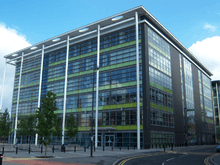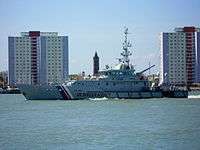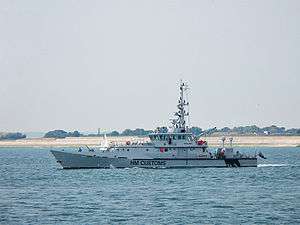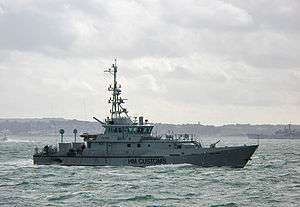Border Force
| Border Force | |
|---|---|
|
Logo of the Border Force | |
| Agency overview | |
| Formed | 1 March, 2012 |
| Preceding agency | UK Border Agency |
| Employees | 8,000 |
| Legal personality | Governmental: Government agency |
| Jurisdictional structure | |
| National agency (Operations jurisdiction) | United Kingdom |
| Legal jurisdiction | United Kingdom |
| General nature | |
| Specialist jurisdiction | National border patrol, security, and integrity. |
| Operational structure | |
| Overviewed by | Independent Police Complaints Commission/Her Majesty's Inspectorate of Constabulary |
| Agency executive |
Sir Charles Montgomery, Director General |
| Parent agency | Home Office |
| Facilities | |
| Cutters |
|
| Website | |
| www.gov.uk/border-force | |
Border Force is a part of the Home Office, responsible for frontline border control operations at air, sea and rail ports in the United Kingdom. The force was part of the now defunct UK Border Agency from its establishment in 2008 until Home Secretary Theresa May demerged it in March 2012 after severe criticism of the senior management.[1]
Since 1 March 2012, Border Force has been a law-enforcement command within the Home Office, accountable directly to ministers.[2] The work of the Border Force is monitored by the Independent Chief Inspector of Borders and Immigration.
Responsibilities
The stated responsibilities of the Home Office's Border Force are the following:[3]
- To check the immigration status of people arriving in and departing the UK.
- To search baggage, vehicles and cargo arriving in the UK for illicit goods or illegal immigrants.
- To patrol the UK coastline and search vessels to prevent smuggling with its fleet of 5 cutters (HMC Protector and four 42m cutters).[4]
- To gather intelligence to protect and collect customs revenues for trade crossing the border.
- To alert the police and security services to people of interest attempting to enter or depart the UK.
Powers
Staff hold a mixture of powers granted to them by their status as immigration officers and designated customs officials.
Immigration powers
Immigration officers have powers of arrest and detention conferred on them by the Immigration Act 1971, when both at ports and inland. In practice, non-arrest trained Border Force immigration officers exercise powers under Schedule 2 of the Immigration Act 1971, while inland immigration officers work under S28A-H of the Immigration Act 1971 and paragraph 17 of Schedule 2, as do arrest-trained Border Force immigration officers at the frontier.
Historically, port and inland immigration officers received different training to reflect these different approaches to immigration enforcement, which is now reinforced by inland officers working for Immigration Enforcement, a separate Home Office Command.
"Designated Immigration Officers" are Border Force immigration officers who have been designated with additional detention powers, under Sections 1 to 4 of the UK Borders Act 2007, where a person at a port or airport is suspected of being liable to arrest by a police officer for non-border offences.
Customs powers
Border Force officers, designated as customs officials under the Borders, Citizenship and Immigration Act 2009, have wide-ranging powers of entry, search, seizure and arrest. They hold the same customs and excise powers as officers of HM Revenue and Customs, but cannot use HMRC powers for non-border matters, such as Income Tax and VAT. Amongst their powers is the ability to arrest anyone who has committed, or who the officer has reasonable grounds to suspect has committed, any offence under the Customs and Excise Acts. They may also seize prohibited and restricted goods, such as controlled drugs and firearms, as well as ensuring that imported goods bear the correct taxes and duties.[5]
Leadership
The first Director General of Border Force was the former Chief Constable of Wiltshire Police Brian Moore, who was appointed on secondment on an interim basis to last until 31 August 2012 and was expected to apply for the position permanently, despite criticism of his management of passport queues.[6] On 10 July 2012, Immigration Minister Damian Green confirmed that Moore had not applied for the post, despite Moore earlier telling the Home Affairs Select Committee that he would be applying.
Tony Smith was appointed as interim Director General of Border Force on 19 September 2012.[7] Smith was previously Gold Commander for the joint UKBA and Border Force Olympics and has spent forty years in border control and enforcement work.
Vice-Admiral Sir Charles Montgomery was named as the new Director General on 25 January 2013.[8]
Organisation

Border Force has five operational regions: Central; Heathrow; North; South; and South East & Europe. The regions have responsibility for securing the border 24 hours a day, 365 days a year at the UK’s ports, airports, postal depots and rail. This includes the Eurostar from Brussels and Paris to St Pancras International and the Eurotunnel from Coquelles to Folkestone.
The regions’ varied work includes stopping 100 per cent of passengers arriving at ports or airports for immigration controls. Officers also conduct risk-led interceptions for controlled drugs, cash, tobacco, alcohol, firearms, offensive weapons, prohibited goods, counterfeit goods and clandestine entrants. They do this at passenger and freight controls, covering passengers travelling on foot, by car, coaches, freight vehicles, as well as air freight and sea containers.
Rank insignia
Uniformed Border Force officers have their rank displayed on shoulder epaulettes, attached to their shirt, jumper or jacket. Warranted officers below Senior Officer rank may also have their identification number displayed. The rank and epaulette styling is in line with many other border agencies and shares close similarities with its Australian counterpart, the Australian Border Force
Equipment
Officer equipment
Border Force officers wear a uniform with rank insignia. Border Force uniform is navy blue and, currently, modelled on the Metropolitan Police uniform. Border Force officers can make use of body armour and carry handcuffs, as well as ASP batons. Leg restraints are also in circulation. Officers also carry Tetra radios on the secure Airwave network, often with earpieces, to communicate with other officers.[9] In addition, officers may also carry other useful police equipment, such as torches.
Specialist forgery detection equipment is available at ports and airports to identify false passports and identity documents. Customs officials make use of a variety of specialised tools and equipment when searching cars, lorries, aircraft, container ships and other items crossing the border.
Vessels
All vessels of the Border Force bear the ship prefix "HMC"—Her Majesty's Cutter. Between May and October 2015 two of the vessels, HMC Protector and HMC Seeker, were deployed in the Mediterranean conducting search and rescue operations. The Border Force also has a recently chartered vessel named MV VOS Grace.[10]
| Ship | Class | Entered service | Displacement | Type | Homeport | Note |
|---|---|---|---|---|---|---|
| HMC Protector | Telkkä-class | 2014 | 434 tonnes | Cutter | Portsmouth[11] | [12] |
| HMC Seeker | UKBF 42m Customs Cutter | 2001 | 257 tonnes | Cutter | ||
| HMC Searcher | UKBF 42m Customs Cutter | 2002 | 257 tonnes | Cutter | ||
| HMC Vigilant | UKBF 42m Customs Cutter | 2003 | 257 tonnes | Cutter | ||
| HMC Valiant | UKBF 42m Customs Cutter | 2004 | 257 tonnes | Cutter |
-

Searcher
-

Vigilant
-

Valiant
See also
- ePassport gates
- Her Majesty's Coastguard
- Her Majesty's Naval Service
- List of customs cutters of UK Border Force
- Marine Scotland
- Visa requirements for the United Kingdom
References
- ↑ "Theresa May to split up UK Border Agency". BBC News. Retrieved 4 August 2016.
- ↑ "Home Secretary's statement on border security - Oral statements to Parliament - GOV.UK". Retrieved 4 August 2016.
- ↑ "Inside government: Border Force". UK Government (gov.uk). Retrieved 20 May 2013.
- ↑ "Revenue Cutters - Current Fleet". Revenue Cutter Association. Retrieved 23 November 2013.
- ↑ "Section 138, Customs and Excise Management Act 1979 (c. 2)". Office of Public Sector Information. Archived from the original on 11 October 2010. Retrieved 12 April 2012.
- ↑ David Millward (22 May 2012). "Border Force chief faces battle to keep job over threat of four-hour immigration queues during Olympics". The Telegraph. Retrieved 2 July 2012.
- ↑ Home Affairs Select Committee, 18 September 2012
- ↑ "New Director General of Border Force announced". Home Office. 25 January 2013. Retrieved 10 February 2013.
- ↑ UK Border Force Documentary, Season 2, Episode 3 (YouTube)
- ↑ "Migration: Mediterranean Sea:Written question - 24322". Retrieved 4 August 2016.
- ↑ HMC Protector: Customs patrol boat launched, bbc.com, 17 March 2014 - "It will be located in Portsmouth and will operate around the UK coastline."
- ↑ "Home Secretary launches new Border Force cutter to protect UK coastline". gov.uk. HM Government. Retrieved 23 April 2015.
External links
| Wikimedia Commons has media related to Border Force. |

.svg.png)